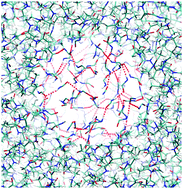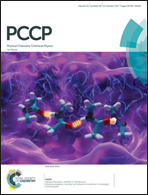Structural relaxation, viscosity, and network connectivity in a hydrogen bonding liquid†
Abstract
In liquids, the ability of neighboring molecules to rearrange and jostle past each other is directly related to viscosity, the property which describes the propensity to flow. The presence of hydrogen bonds (H-bonds) complicates the molecular scale picture of viscosity. H-Bonds are attractive, directional interactions between molecules which, in some cases, result in transient network structures. In this work, we use experimental and computational methods to demonstrate that the timescale of H-bond network reorganization is the dominant dynamical timescale associated with viscosity for the case of the model H-bonding liquid n-methylacetamide (NMA). This molecule is a peptide analog which forms a transient linear H-bond network. Individual H-bond lifetimes and dynamical fluctuations were observed on the timescale of 1.5 ps, while collective motions and the longest lived population of H-bond partner lifetimes were observed on the order of 20 ps, in agreement with the Maxwell relaxation time. This identifies a mechanism which may aid in understanding the emergence of various complex phenomena arising from transient molecular structures, with implications ranging from the internal dynamics of proteins, to the glass transition, to better understanding the origins of the unique properties of H-bonding liquids.



 Please wait while we load your content...
Please wait while we load your content...